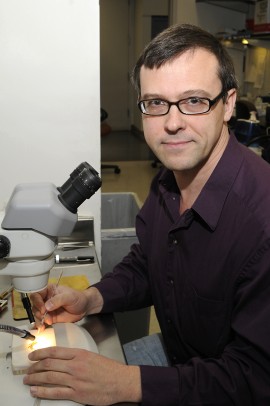Dysfunctional mitochondria may underlie resistance to radiation therapy

Maxim Frolov, associate professor of biochemistry and molecular genetics. Photo: UIC Photo Services (click on image for larger size)
The resistance of some cancers to the cell-killing effects of radiation therapy may be due to abnormalities in the mitochondria – the cellular structures responsible for generating energy, according to an international team of researchers. Their findings are published in the Nov. 25 issue of Developmental Cell.
Maxim Frolov, associate professor of biochemistry and molecular genetics at the University of Illinois at Chicago, and colleagues investigated the effects of a mutation in a gene called E2F, which controls other genes responsible for initiating programmed cell death, a normal function in most cells. Cells undergo programmed cell death — or apoptosis — when they are no longer needed, as a normal part of aging, or in response to environmental factors like radiation that damage cellular DNA.
When Frolov and colleagues exposed fruit flies carrying a mutant E2F gene to radiation, genes that initiate apoptosis were activated, but the flies did not die.
“Something else was preventing the flies from dying, even though the genes needed to undergo cell death were turned on,” Frolov said.
A closer look within the cells of the flies revealed that their mitochondria were misshapen and produced less energy than normal mitochondria. Flies with the most severely deranged mitochondria were the most resistant to radiation-induced cell death.
The observation in fruit flies suggested a previously unknown role for the E2F transcription factor — the protein encoded by E2F that regulates expression of other genes — in mitochondrial function.
“It seems their mitochondria were also affected by the E2F mutation and were not functioning at full strength,” said Frolov. “You need properly functioning mitochondria to carry out programmed cell death.”
Turning to human cells, the researchers found the same effects: those that lacked the E2F gene were resistant to the effects of radiation. Frolov said the similarity in the findings shows that basic cellular functions do not change much across the vast evolutionary distance between fruit flies and humans.
“This result highlights a remarkable degree of conservation between fruit flies and humans and illustrates the advantages of using model organisms in cancer research,” said Frolov, whose laboratory is part of the UIC Cancer Center.
Frolov and his colleagues think that dysfunctional mitochondria might underlie the differences in how patients respond to radiation therapy. Previous studies have suggested that the inability of some patients’ mitochondria to support apoptosis might account for differences in their response to chemotherapy for acute myelogenous leukemia.
“If we could develop a small-molecule drug that could enhance mitochondrial function in these patients, we may be able to improve the effectiveness of radiation therapy,” Frolov said.
Coauthors of the study are Elizaveta Benevolenskay, associate professor of biochemistry and molecular genetics in the UIC Cancer Center, UIC graduate student Aaron Ambrus and postdoctoral research associate Katherine Holmes, Abul Islam and Nuria Lopez-Bigas of Universitat Pompeu in Barcelona, Spain, and Nam Sung Moon of McGill University in Montreal.
The research was supported by grants CA138631 and GM93827 from the National Institutes of Health, a Scholar Award from the Leukemia and Lymphoma Society, grant 355760-2008 from the Natural Science and Engineering Research Council of Canada, and by grants SAF2009-06954 and SAF2012-36199 from the Spanish Ministry of Economy and Competitivity.
